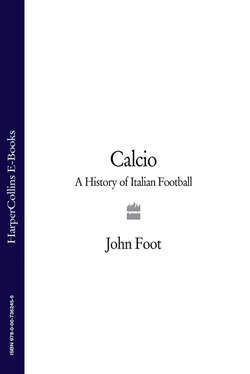Читать книгу Calcio: A History of Italian Football - John Foot - Страница 10
The first championship
ОглавлениеIn May 1898, Italy’s first football championship took place in Turin, in one day. Official records date from here. Genoa’s victory in 1898 thus counts as a championship success, with the same statistical weight as that of 2004. The three-month-old Italian football federation brought together four teams for the tournament, three of whom were from Turin, along with Genoa.
For many years, championships were not fought out in a modern, league-type system but through ‘challenges’ similar to short cup competitions. All three matches in 1898 were played in a field on the edge of Turin, which bore little resemblance to the industrial city that was to sprawl across the Piedmont plains in the twentieth century. Players from all four teams took trams to the pitch and the first championship game was a derby, between two Turin-based clubs. Played at nine in the morning on 8 May, it finished 1–0 to Internazionale di Torino with John (Jim) Savage, who was a marquis and the team captain, scoring the winner.3 Genoa (in white shirts) won their semi-final against Ginnastica di Torino 2–1 and the final, against Internazionale (at three in the afternoon, after a sandwich lunch), by the same score, after extra-time. Spensley was in goal for Genoa. The team contained three other British players and at least five foreigners. Genoa took home a cup – donated by the Duke of the Abruzzi – and each player was given a gold medal.
Italy’s first football champions were therefore a club with an English name, Genoa. There were only around 50 spectators for the semi-finals and little over 100 for the final. As well as a referee (whose name remains unknown) there were two seated ‘line-judges’ whose job it was to adjudicate if the ball had crossed the goal line, or not, as there were no goal nets. According to football historian Antonio Ghirelli, the crowd cheered their teams and even fought briefly amongst themselves. They also booed the referee, ‘a habit which would continue’, he dryly notes.4 The total takings were 197 lire. Football was way down the list of popular sports in Italy at the turn of the century, coming something like seventh in the reporting hierarchies in the newborn sports press. Cycling, riding, motor sports and hunting were all far more popular pastimes.
The small crowd was understandable. Many people had other things on their minds. May 1898 was not a particularly happy time for Italian society as a whole. As Genoa celebrated its first championship in Turin, Milan was in chaos. Bread riots had led to barricades going up across the city. The government decided to repress the protests and the army was sent in. To this day, nobody knows how many protestors (and bystanders) were killed, but modest estimates put the number at 400. Martial law was declared, soldiers camped in Milan’s central Piazza del Duomo and mass arrests were carried out, including priests and moderate reformists. King Umberto I rewarded General Bava Beccaris, at the head of the military operation, with a special medal.5 All eyes were on Milan, as Italian society tore itself apart, and little attention was given to three ninety-minute games on the dusty periphery of Turin.
